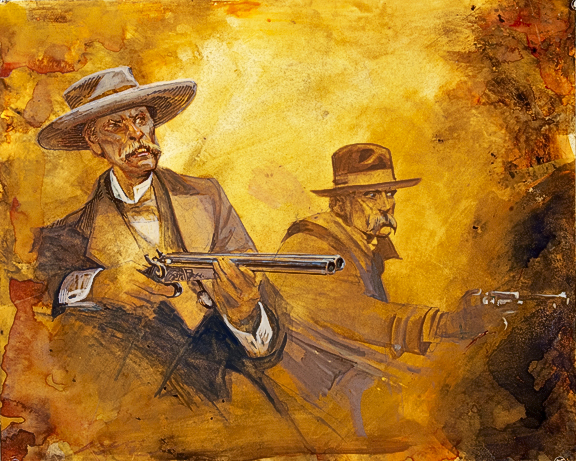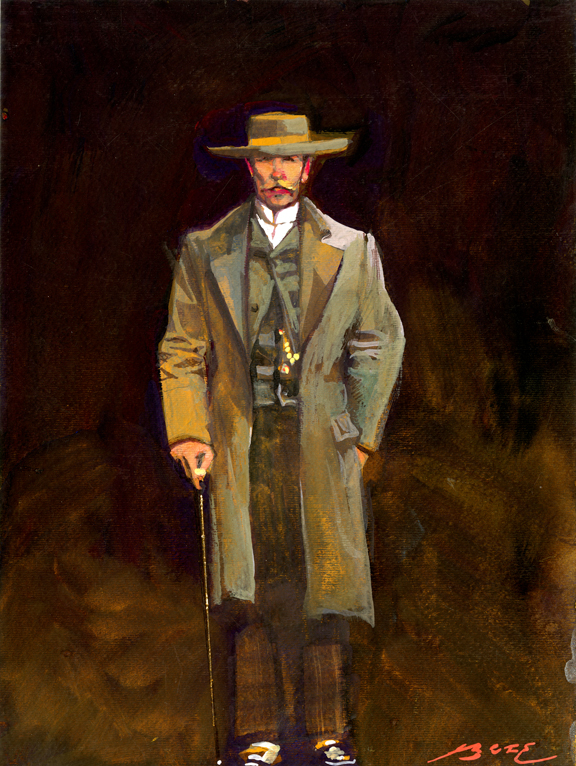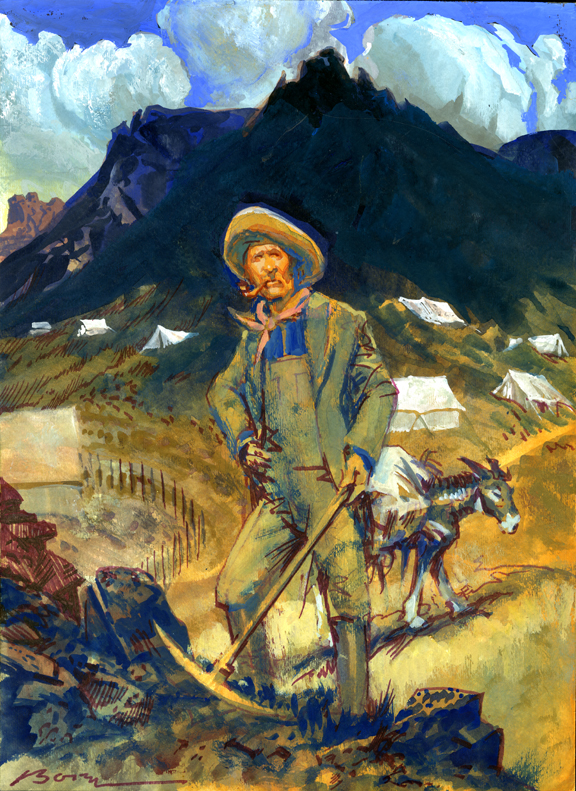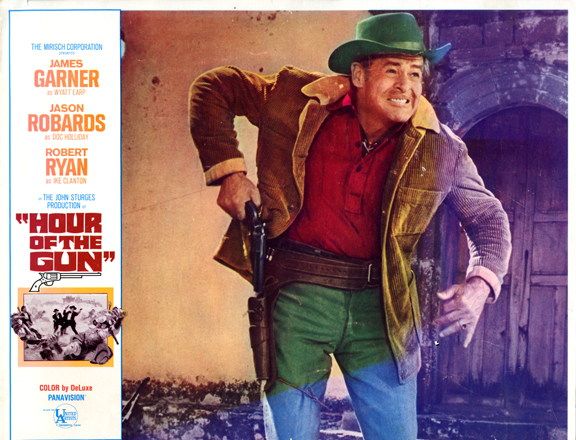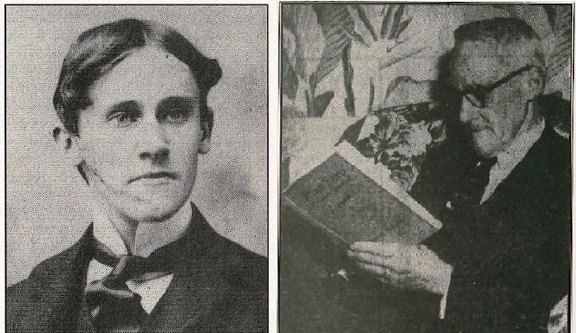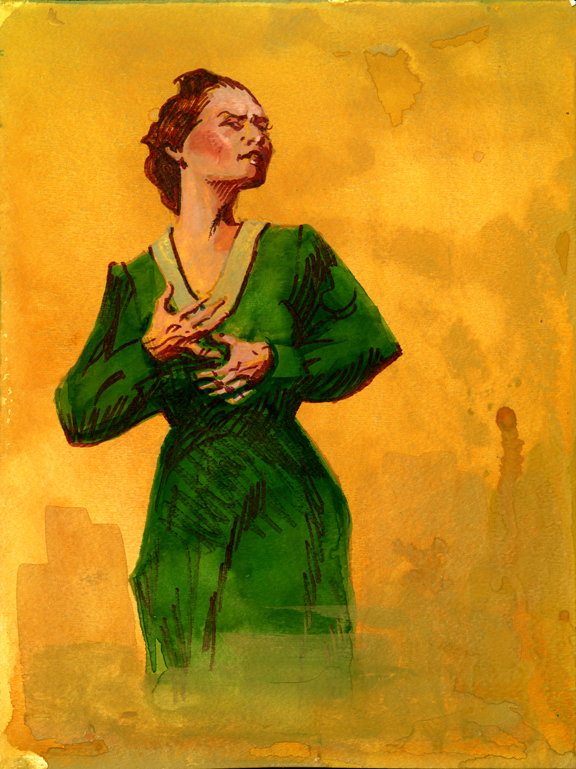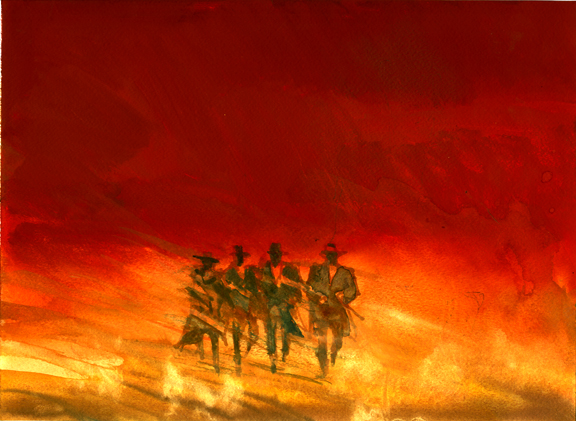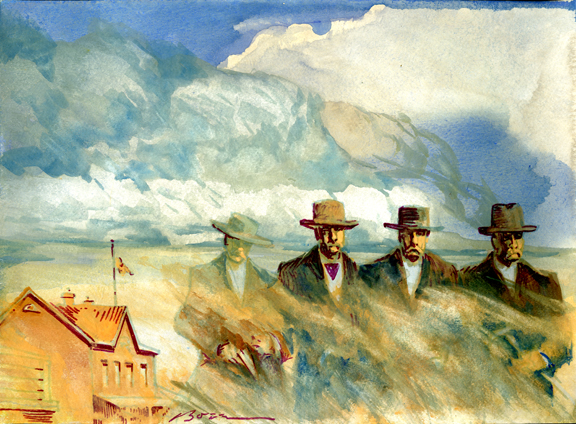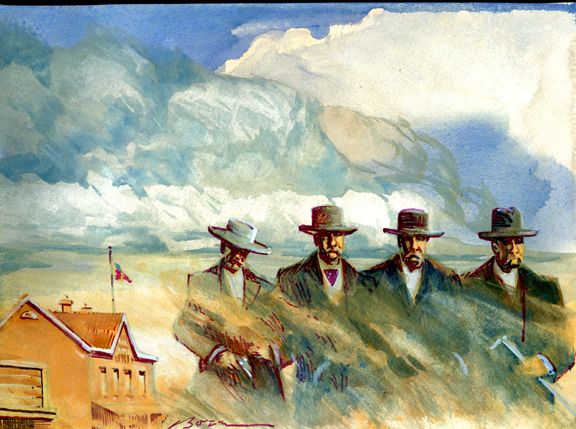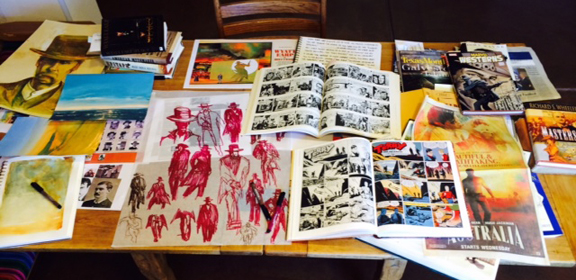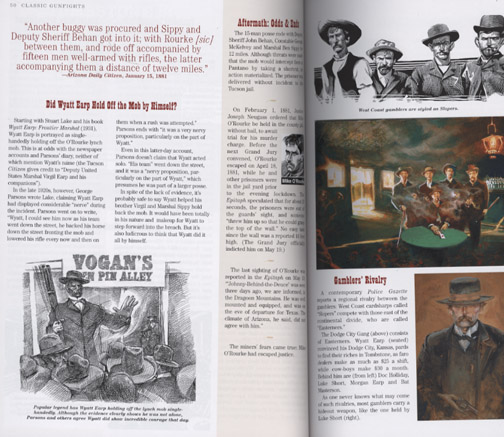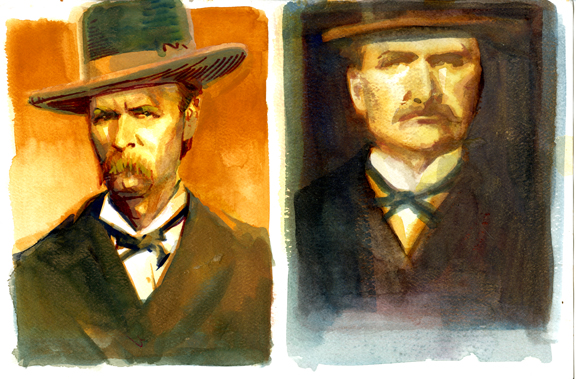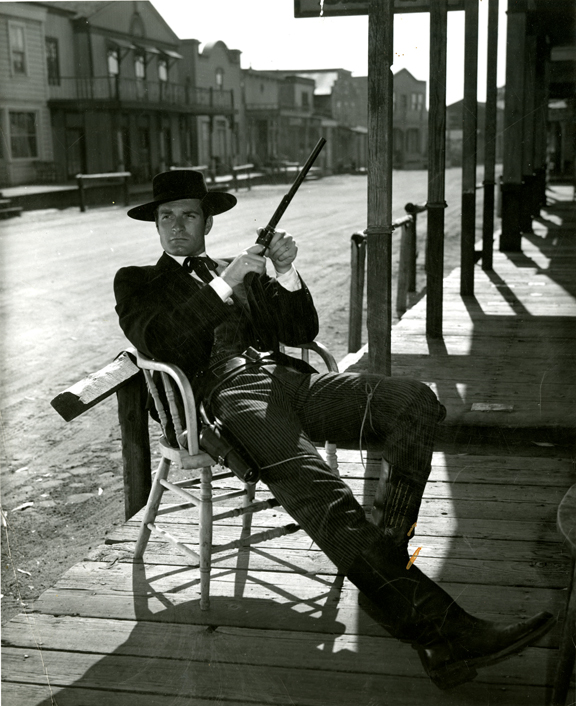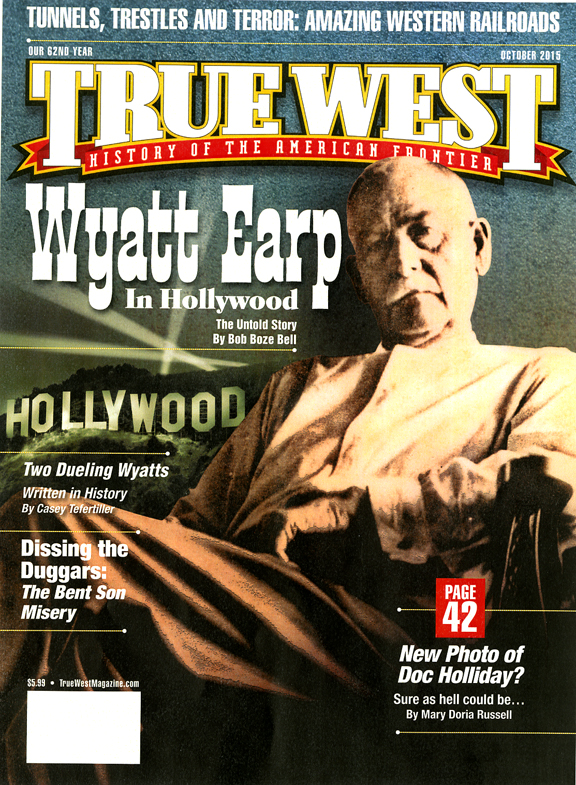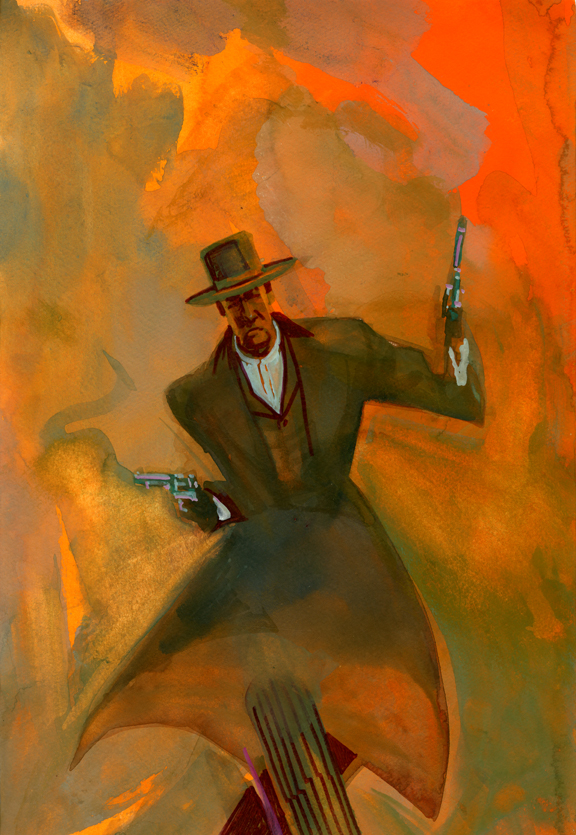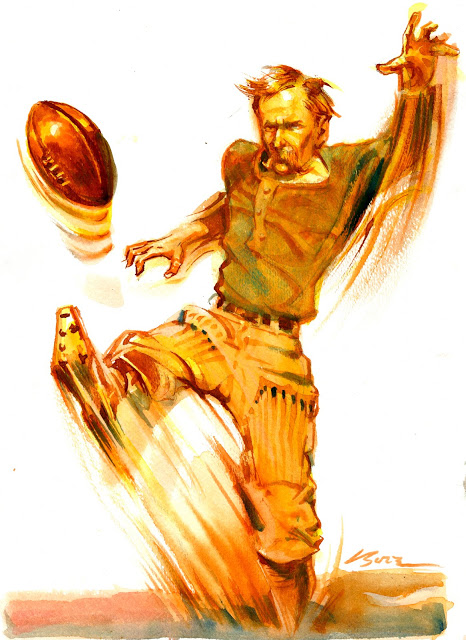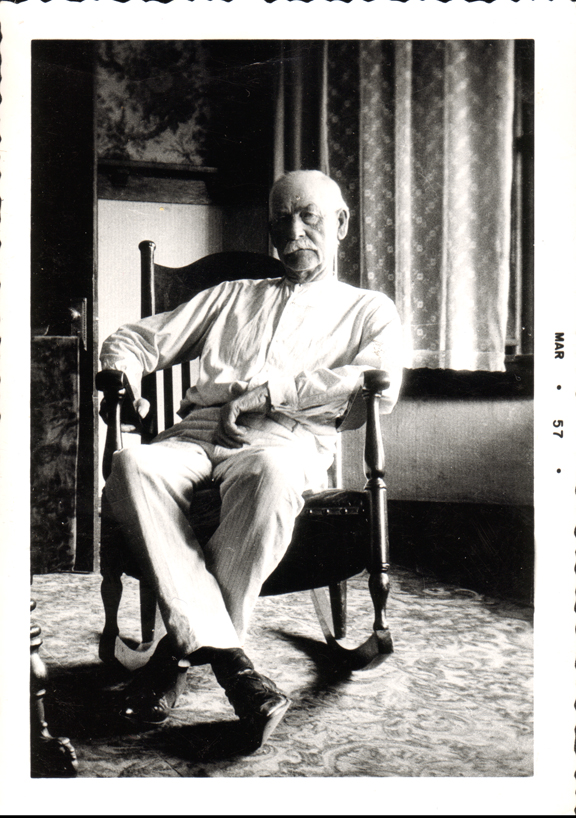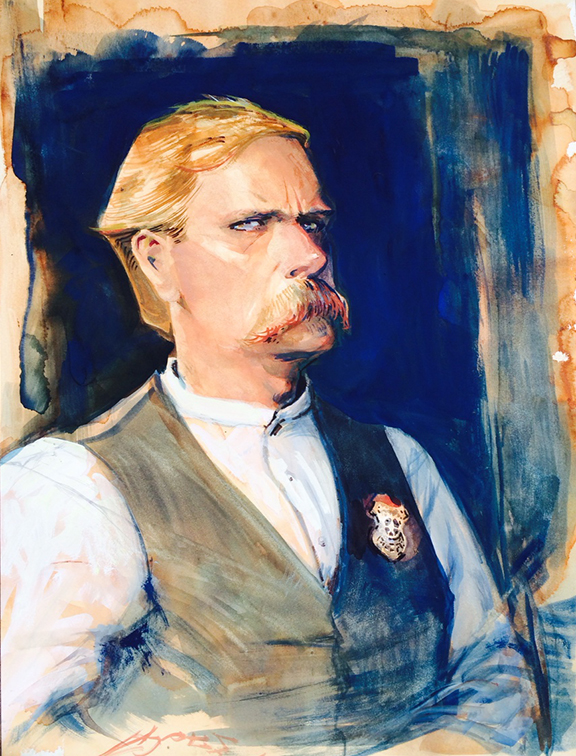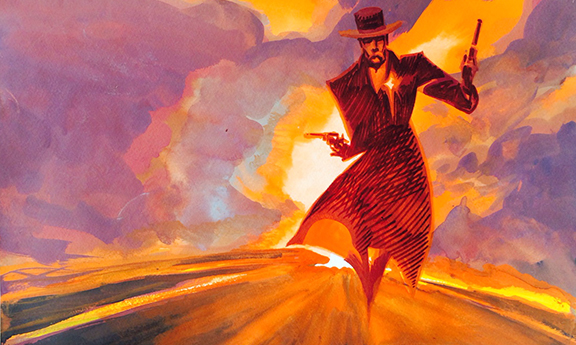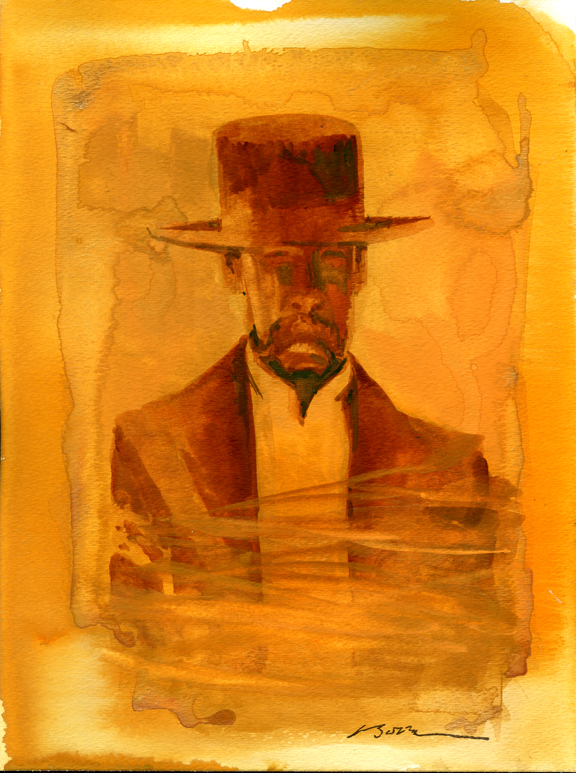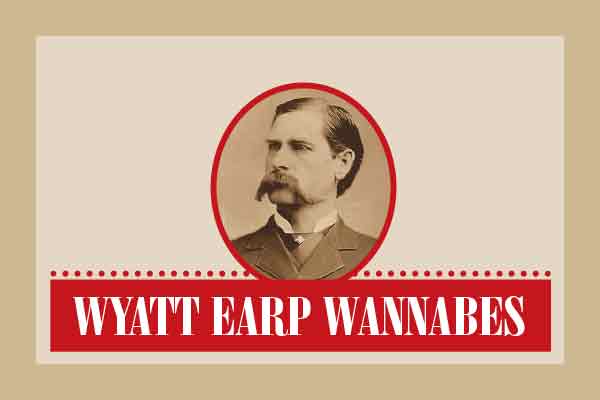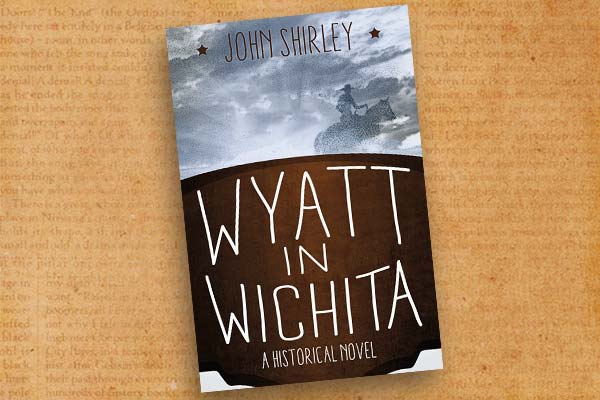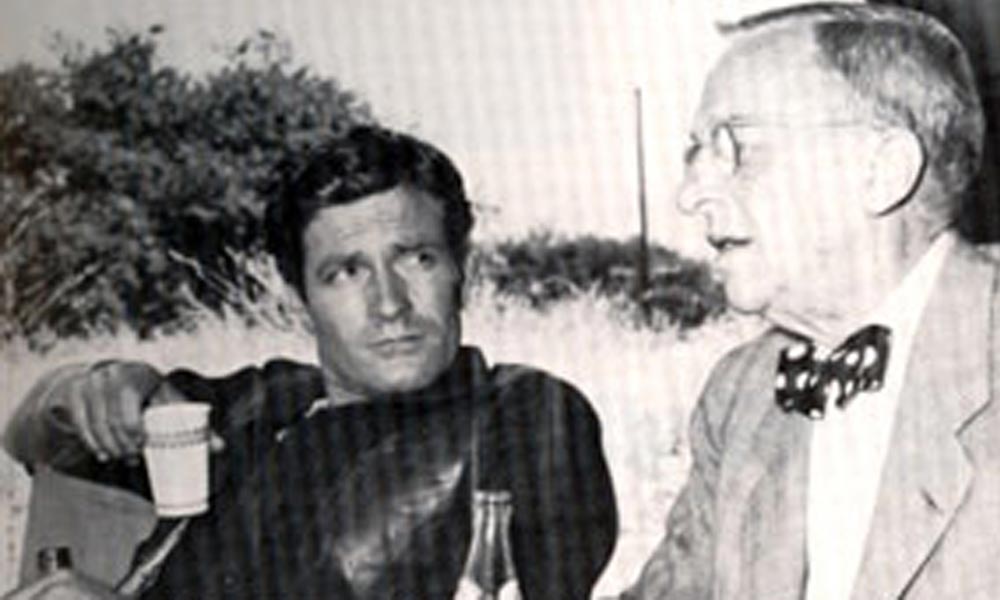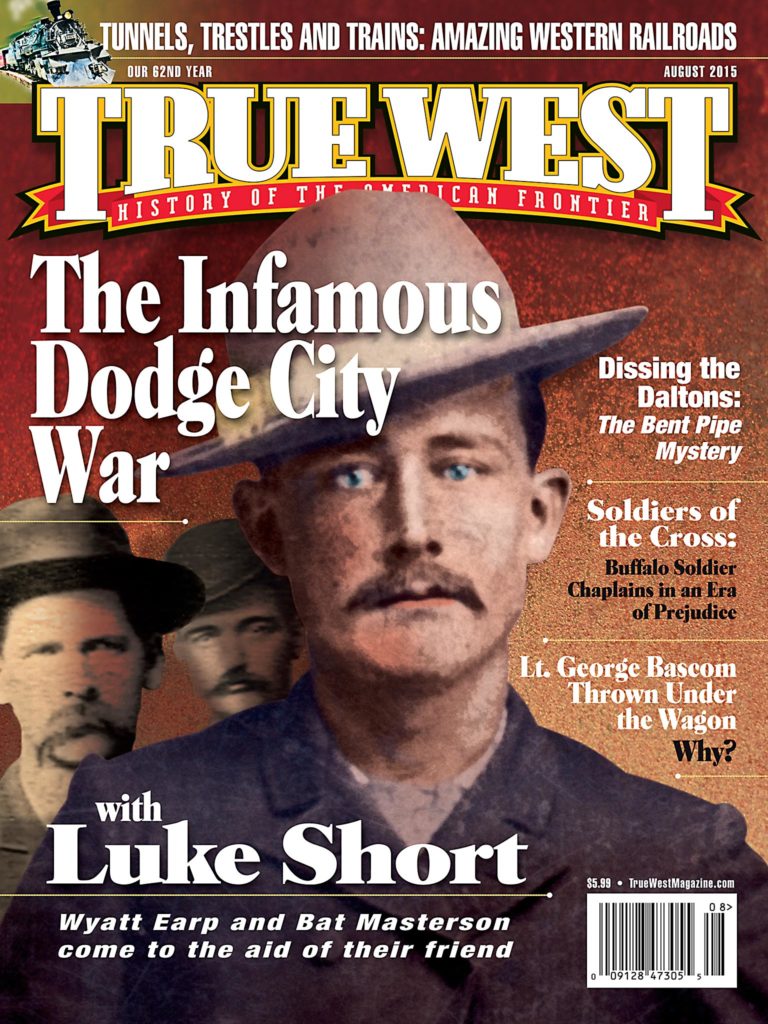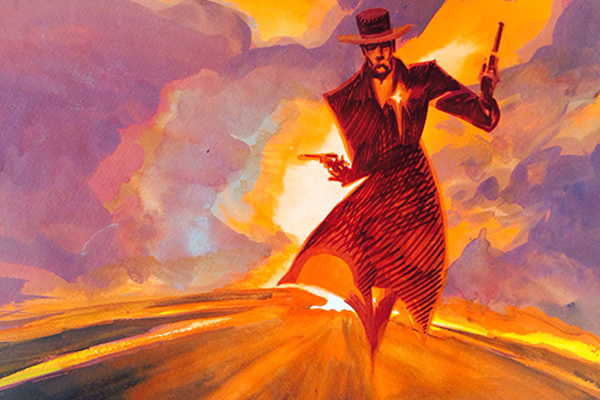 With all of the articles we have done about Wyatt Earp over the years, you might think we could just slap a few anecdotes and photographs on the page and call it a day. That couldn’t be any further from the truth. Here are some entries from the blog of True West Executive Editor, Bob Boze Bell, that show only a fraction of the work we put into our October 2015 issue.
With all of the articles we have done about Wyatt Earp over the years, you might think we could just slap a few anecdotes and photographs on the page and call it a day. That couldn’t be any further from the truth. Here are some entries from the blog of True West Executive Editor, Bob Boze Bell, that show only a fraction of the work we put into our October 2015 issue.
July 18, 2015
The Truth About Wyatt Earp
Still wrestling with the truth about Wyatt Earp. Why is it so important to me? My mother’s side of the family doesn’t even like him, so it seems weird on a certain level to be so obsessed with what he did and what he did not do.
John Gilchriese said to me, “You won’t like him. He’s not who you think he was” And, by the way, Gilchriese knew John Flood intimately.
We now know Earp was invovled in prostitution, to what degree it’s hard to say, but when a newspaper says, after his second arrest, that he’s “an old offender,” you kind of have to admit where there’s smoke there’s usually a smoking, paid for, vagina.
He took credit for a variety of things he didn’t do. He didn’t kill John Ringo. He didn’t disarm Ben Thompson. He didn’t stand off the Johnny Behind The Deuce mob all by himself. He may not even have killed Curly Bill.
Still, when he was in his prime he was bold and by all accounts, a ladies man. All of this played into the painting I finished this morning.
I really shouldn’t like him. I hate historical fakery with a passion, but, Gilchriese was wrong: I have a very good idea of what he did and didn’t do and, in spite of that, I like him. For starters, we love the same thing. In the Flood manuscript, he tells us twice what he loves, and here it is for the second time:
“The same desert that thrilled him through and through, at old Tucson, and the same blue sky: there isn’t any blue like it anywhere, and Wyatt Earp loves it, and the sunshiny sun and the sands that blow upon him.”
—John Flood on the last page of the 348 page manuscript on Wyatt Earp
July 19, 2015
Wyatt Earp Super Marshal
There were a bunch of false starts and fizzled efforts, but when the Wyatt Earp legend finally took hold in the 1930s it hit like an explosion.
And as the thirties gave way to the forties and World War II, the Earp legend hit a new high with “My Darling Clementine” in 1946, but the pop phenom still had higher to go. In the fifties we get “Gunfight at The O.K. Corral” and then the hit TV series “The Life And Legend of Wyatt Earp.” That was the top of the roller coaster and in the early sixites the blow back began with the publication of “The Earp Brothers of Tombstone” by Frank Waters and then we get “Doc,” an anti-war flick that implies Doc and Wyatt were gay and by the eighties we get the remake of “The Lone Ranger” (no, the earlier one that was just as bad as the latest one with Johnny Depp) and if you’ll remember the crooked lawman was named “Earp.” But, of course, the legend got a big rebound in 1993 with “Tombstone” and then “Wyatt Earp” in 1994, so quite a bumpy ride for the old frontiersman who never could sell his life story. In fact, I think I know what his last words were in reference to:
“Suppose, suppose, I actually got paid for my life story?”
—Wyatt Earp as quoted by BBB in a moment of wild speculation
July 20, 2015
The Wyatt Earp Myth: Who Exaggerated And Why?
Now that I have a working knowledge of what Wyatt Earp claimed to have done in the Flood manuscript, we can start to see the progression of the myth-making process by comparing Wyatt’s claims in the Flood, and then comparing those claims to Burns and, finally, to Lake. Let’s start with a controversial episode: did Wyatt Earp stand off the Johnny Behind The Deuce mob single-handedly?
In the Flood manuscript, Wyatt claims that a telephone call to the office of the Toughnut Mine informing Tombstone that “Johnny Behind The Deuce had shot the mine engineer at Charleston, and the Earps were aiding his escape.” First of all, it is possible that the news reached Tombstone via a telephone since the mines had the latest technology and telephones connected from the mines to the Tombstone Stock Exchange, so that part, ahem, rings true. The second claim, that the Earps were aiding Mr. Deuce’s escape has some validity, since the miners from Charleston who were chasing the killer saw that “the gambling element” in Tombstone was aiding his getaway (supposedly, the acting lawmen, Virgil Earp and Johnny Behan, requested their help). This, of course, incensed the mob because they felt that justice would not be done and that the gamblers of Tombstone were protecting one of their own. A very logical conclusion on the part of the Charleston crowd who didn’t want Johnny Behind the Deuce to escape justice for a brutal killing.In the Flood version, earlier in the day, Virgil had taken Wyatt’s horse Dick Naylor out for a ride and happened upon the buckboard with Deuce in it fleeing the horde following them. Virgil Earp takes the prisoner up behind him and rides into Tombstone (Burns claims Deuce was rescued on Jack McCann’s filly Molly McCarthy)), Johnny blurts out he and the mining engineer were in a card game when the fight broke out. This is not true. Contemporary accounts note that the combatants were in a restaurant in Charleston and Schneider, the mining engineer, insulted Johnny (there is speculation that Deuce was behind a burglary at Schneider’s cabin). Burns gives the correct version. Better research? Was Wyatt’s memory faulty? Was that the scuttlebutt—the ill-fated card game—at the time and that’s the way Wyatt remembered it? Still, Burns version is correct and the Flood is wrong on this point.
In the Flood version, as the mob approached, Wyatt “had planned it all as he heard the first warning rumble up the street, and he began to make his vision real. He sent his brothers Virgil, Morgan and James, and Charlie Smith over to the impromptu jail in charge of the prisoner, and a moment later after locking the door to the place, he followed them to make sure of the barricade.”
“And then he stepped into the street.” Wyatt claims there were 300 in the mob and they were coming at a run. He describes the scene of the mob armed “with picks and shovels were in their hands, and rifles and shotguns and long bars; implements that they had seized in hate, weapons that would kill and maim.” He compares the scene to the French Revolution (that’s probably Flood).
And then Wyatt is alone facing the mob and “The venom of reptiles, the malice and the envy of bitter men, the wild, delerious [sic] frenzy of fanatics, the will of hate and vengeance fixed itself in the faces, almost adamantine, of the standing horde.” Then:
“What do you want!” [Earp] demanded.
“We want Johnny!” some one shouted.
“Come and get him!” he hurled back, and he advanced a step towards the mob and they, of course back down.
End of Flood version
Here is Burns’ version: “Wyatt Earp was dealing faro in the Oriental.” Thank you! We never quite know where Wyatt is in the Flood version. We want details, smells, clothing, rifle specs, but no! The constable from Charleston with his prisoner, Mr. Deuce comes running in: “Mob coming. Going to lynch this boy. Hurry up. Do something, for Christ’s sake. No time to lose.”
Cool as a cucumber, Earp finishes his faro game and closes the box and says, “Hold on to your chips, boys. I’ll cash ’em as soon as I’ve finished with this little business matter.” Then Burns adds a classic line: “As a gambler, he pushed back his chair. He rose as an officer of the law.”
Sweet. Excellent. Such a wonderful relief from trying to read Flood.
In the Burns’ version, Wyatt Earp escorts the prisoner to Vogan’s bowling alley and “he posted Virgil Earp at the rear and Doc Holliday behind the locked front door.”
And, of course, Wyatt steps into the street to face the “brutes stirring to fury, the note of menace unmistakable.” [Burns is so clean and succinct and good and he makes Flood look so bad.]
Burns stretches out the dialogue:
“Where ‘ve you got that murdering rat hid?”
“He’s right in there.” Wyatt Earp jerked his thumb at the bowling alley. ” And he’s going to stay in there. He’s my prisoner now, and you fellers ain’t goin’ to get him.”
“The hell we ain’t.”
Wyatt Earp cocks both barrels of his shotgun and says, “Come on, then, you yellow curs. Let’s see you get him.”
“His booming voice was like the roar of a lion at bay as he flung the challenge in the mob’s teeth. . .one foot advanced, his shotgun held tensely across his breast read for instant action, Wyatt Earp stood, one man against five hundred.”
Okay, so Burns has amped up the number by two hundred (Earp claimed it was 300) and Burns goes to the well one more time about Wyatt being the Lion of Tombstone. It’s all very persuasive, because Burns is such a good writer and he knows how to elevate the material to poetry and, ultimately, Myth.
End of Burns’ Version
And, so now, we come to Stuart Lake. In his version of the Johnny-Behind-the-Deuce affair, Lake goes with the deadly card game and has Schneider drawing a knife before being shot. That’s one point for Burns and minus one point for both Flood and Lake.
As in the Burns version, Lake has the pursued buckboard stop at Jack McCann’s but then says, “Yarn-spinners have sent Jack McCann to the constable’s aid on his race-mare Molly McCarthy. The horseman who met McKelvey by chance was Virgil Earp, riding Dick Naylor, a thorrough bred animal belonging to Wyatt.”
So Lake give Burns a slap down and one-ups him to boot. Moving on to Tombstone, in Lake’s version, “Virgil found Wyatt and Morgan at the Wells-Fargo office.”
“Take him into Vogan’s,” Wyatt told Virgil and Morgan.
“Five hundred blood-lusting frontiersman poured into Allen Street as Virgil and Morgan got Johnny-Behind-the-Deuce into the bowling alley. Wyatt stood alone at the curbline, his shotgun in the crook of his arm.”
The mob wants Johnny, but Wyatt is rather quiet. He says, “Boys, don’t you make any fool play here; that little tinhorn isn’t worth it.”
Lake quotes Wyatt as saying, “Most accounts have me cursing that crowd plenty, but that was no time for hot language.”
In Lake’s crowd, “every man had a shotgun, rifle or six-gun, ready to pour lead into the lone peace officer.”
Lake has Wyatt spot Dick Gird, the “multi-millionaire, employer of half of the men at his back. Wyatt points the shotgun at Gird and cooly says, “Nice mob you’ve got, Mr. Gird, I didn’t know you trailed with such company.” Gird talks the mob down after Earp points the shotgun at his belly.
Okay, so both Burns and Lake have amped up the crowd number from 300 to 500, none of them agree on who was where in terms of the prisoner (Wyatt has Virgil putting him in the impromptu jail and Burns and Lake have him in Vogans). The dialogue is all over the place and Wyatt seems to get braver and braver with each telling. So what did the contemporary newspaper report say of the affair? Here’s the January 17, 1881 Tombstone Epitaph:
“In a few minutes Allen street was jammed with an excited crowd, rapidly augmented by scores from all directions. By this time Marshal Sippy, realizing the situation at once. . .secured a well armed posse of over a score of men to prevent any attempt o the part of the crowd to lynch the prisoner. . .[he] procured a light wagon in which the prisoner was placed, guarded by himself, Virgil Earp and Deputy Sheriff Behan, assisted by a strong posse well armed.” It ends by saying, “Marshal Sippy’s sound judgement prevented any such outbreak as would have been the certain result, and cool as an iceburg he held the crowd in check.”
Ah, Ben Sippy is the brave one and he’s not even mentioned in any of the versions we just painstakingly went through. In addition, we have Johnny Behan—yes, THAT Johnny Behan— helping the cause and he’s not in any of the above versions becuase there is no way Wyatt would give him credit for anything. So that taints all three versions. What we have here is obvious exaggeration to the point of ridiculousness. And they all did it for one reason: the money. Ironic that Burns and Lake actually made good money but Wyatt Earp never made a dime. Yet, all three versions came from Wyatt. What was the need to lie like this? To be vindicated? To be famous? To be rich?
“What seems a lie is a ramshackle need, waiting to be born.”
—Ray Bradbury
July 21, 2015
Face In The Mob And A Toadie to The Earps
In yesterday’s post I quoted Flood and Burns and Lake on the nature of the mob that confronted Wyatt Earp in front of Vogan’s in Tombstone in the run up to the Johnny-Behind-the-Deuce affair. As a recap, here they are:
Flood’s mob: Wyatt claims there were 300 in the mob and they were coming at a run. He describes the scene of the mob armed “with picks and shovels were in their hands, and rifles and shotguns and long bars; implements that they had seized in hate, weapons that would kill and maim.” He compares the scene to the French Revolution (that’s probably Flood).
And then Wyatt is alone facing the mob and “The venom of reptiles, the malice and the envy of bitter men, the wild, delerious [sic] frenzy of fanatics, the will of hate and vengeance fixed itself in the faces, almost adamantine, of the standing horde.”
Burns’ mob: “brutes stirring to fury, the note of menace unmistakable.”
Lake’s mob: “every man had a shotgun, rifle or six-gun, ready to pour lead into the lone peace officer.”
This is from James Covington Hancock, who was in Tombstone on the day of the stand-off and after Burns’ book came out (Hancock was interviewed by Burns for the book), he, Hancock, claimed that the so-called lynch mob, was nothing more than “a bunch of ‘rubber necks’—I was one of them myself—no one was armed and there was no demonstration of any kind.”
Lest you think Hancock was a ne’er do well Earp-hater and cowboy lover, Mr. Hancock served as a customs collector, justice of the peace, school board member and postmaster of Paradise, Arizona.
Finished up a new version of that Fremont Street fight:
This quote by Flood on Wyatt Earp’s love of the Arizona blued sky is repeated twice. At the end of the book, and on page 106:
“There isn’t any blue like it anywhere, the great, blue sky of old Tucson: that bends above it and hems it in ’round about.”
Another sentence a paragraph later:
“Its sky of blue and its sunshiny sun; and Wyatt Earp stood beneath it, and he loved it, and the sands that blew upon him, in the daytime and when the stars were out.”
And finally, the last word goes to our friend who was part of the mob:
“In my opinion Mr. Burns must have been well paid by Wyatt Earp for writing this book judging by the way he toadies to them. . .it is to be regretted that as brilliant a writer as Mr. Burns is that he would stoop to such a dirty trick for a few dollars.”
—James Hancock, on “Tombstone: An Iliad of The Southwest
July 22, 2015
Who’s The Bigger Fibber? Flood, Lake or Burns?
This is a great question:
I have always wondered it Wyatt actually told Burns all the tall tales or if he told the real stories of Wichita and Dodge and Burns changed the hero to Wyatt. If Burns actually talked to people in Wichita and Dodge or did any research he would have seen Wyatt did not participate in these stories. If so why did he leave them in the book?
—Tom B.
Having just read the Flood manuscript, and after comparing it to Burns and Lake I think I have a pretty good idea of what happened: Wyatt is exaggerating his exploits in the Flood manuscript trying to make it commercial as a book and a possible movie. No problem there. Plus Wyatt was just about the last guy standing, with the possible exception of John Clum and Billy Breakenridge. Bat Masterson died a couple years before (and allegedly said the true story of the west will never be known until Wyatt Earp talks!), Morgan, Warren, James and Virgil were gone, Behan was gone, Earp mentions in the Flood manuscript he is the last guy standing from the Peace Commission photo. So he probably thinks there is no harm amping up his exploits a little to make a buck. In the Flood manuscript, Wyatt claims to have backed down Clay Allison in Dodge (they have a testy showdown with Wyatt standing in the street and Allison on horseback, and Allison leaves without firing a shot). Could have happened.
Either Lake or Burns, I can’t remember which, actually attended a reunion of old-timers in Dodge and interviewed them. Now, the last place you would go seeking the truth is a reunion. Hip boots required. If you don’t believe me drop in on your high school reunion and listen to the stories. You might think you went to a different school.
At any rate, Stewart Lake came in behind Flood and Burns and amped up everything. We did a comparison in True West about ten years ago, between the Burns and Lake accounts, shot for shot. If Burns says Ike Clanton and crew took two shots at Wyatt in the Tucson Rail-yard, Lake ups it to four (and by the way, nobody shot at Wyatt in the Tucson Rail-yard). In both Burns and Lake, in every single fight, there are more shots fired than the record shows. Now, granted neither Burns nor Lake have 109 CRACKs at the O.K. fight, but they are still amping everything up.
Lake added the most egregious fib with this:
With the Buntline Special super weapon, Lake gives Earp his Excalibur (it is not in Flood or Burns). He also quotes Wyatt talking about it, which is highly suspect:
“There was a lot of talk in Dodge about the specials slowing us on the draw,” Wyatt recalled. “Bat and Bill Tilghman cut off the barrels to make them standard length, but Bassett, Brown, and I kept ours as they came. Mine was my favorite over any other gun. I could jerk it as fast as I could my old one and I carried it at my right hip throughout my career as marshal. With it I did most of the six-gun work I had to do. My second gun, which I carried at my left hip, was the standard Colt’s frontier model forty-five-caliber, single-action six-shooter with the seven-and-one-half inch barrel, the gun we called ‘the Peacemaker.'”
This is the biggest load of hooey in the history of the Old West and it doesn’t even sound like Wyatt.
So, of all the B.S., Lake is the biggest fibber and laid it on the thickest, and his book sales and the subsequent movie and TV bonanza showed he gave the public what they wanted: a super lawman for the times. I don’t think it’s too much of a stretch to say Lake turned Wyatt Earp into the Godzilla of the cowtowns. All the lying paid very well.
With all of this on my mind, I got up this morning and did a little portrait with the notation that the past is a murky, hard-to-see-clearly place. Must be all that dust and gunpowder.
“Art will fly if held too lightly, art will die if held too tightly. Lightly, tightly, how do I know whether I’m holding or letting go?”
—Oscar Wilde
July 23, 2015
Sadie The Conniving, Histrionic Diva
She had a mission and she stayed on it until the end of her life. Bossy and paranoid, impetuous and mercurial, she was a beautiful woman who was used to getting her own way. Josephine “Sadie” Marcus Earp was, as they used to say, a handful.
After Wyatt’s death in 1929, she successfully demanded that the title of Stuart Lake’s book be changed from “Wyatt Earp: Frontier Gunfighter” to “Wyatt Earp: Frontier Marshal.” She nixed a photo of Wyatt in shirt sleeves because she said it made him look like a ruffian. She hounded Lake with letters, demanding that “it must be a nice clean story.” The hidden message being there must be no mention of Wyatt’s other wife Mattie, or of Josie’s involvement with Behan in Tombstone. When Lake wouldn’t cave to all of her demands (like Flood had) she started telling people the book was full of “outright lies.” She even traveled to Boston to plead with the publisher to stop the release of the book. They handled her with kid gloves and went on press in spite of her tears and threats.
In 1934, Sadie sued Twentieth Century Fox who produced the first Frontier Marshal, claiming it was an unauthorized biography, so the producers simply changed the name of the main character to Michael Wyatt. A second version of Frontier Marshal starring Randolph Scott was produced in 1939 and Josie threatened to sue once again, but settled for $5,000.
She told her in-laws and extended family members she never received a dime from Stuart Lake, but there are multiple receipts in the Lake Collection at the Huntington Library of monies paid out to Josie Earp for thousands of dollars (there are family rumors she gambled away a good part of the money.)
According to Casey Tefertiller, in spite of her meddling and demands, one of the studios actually hired her to come on set to tell the actors how to portray Wyatt Earp. No doubt her advice emphasized that the actor be sure to talk with “pep” and always wear a jacket!
After reading about her nagging influence and blatant manipulation of the Flood manuscript I have to say, Sadie was one tiny little despot (she was barely over five feet tall). According to Mabel Earp Cason, Josie spoke with a “Brooklynese” accent. No wonder Wyatt tried to say on her good side for 46 years—she was a little pistol!
After her death in 1945 Lake got the contract with Sadie terminated and he kept all proceeds after that. Lake wrote another Wyatt Earp book in 1946 that became the basis for the John Ford film “My Darling Clementine” (1947) and he also got monies for “The Gunfight at The O.K. Corral” (1957) and he was a producer on the TV series “The Life And Legend of Wyatt Earp.”
“You can’t tell me Wyatt was a killer. He lived with Josie for nearly fifty years!”
—Harold Ackerman, who endured a car trip to Tombstone with Josie
July 27, 2015
In my humble estimation, it is the defining moment in Wyatt Earp’s life. Resolute and determined, four men turn the corner on Fremont Street on a blustery, cold day. Taking the middle of the road, they walk shoulder to shoulder to personally confront hard men who have threatened their lives.
Worked all day yesterday on sketches and prep work for this scene:
Got up this morning and took a run at it:
The clouds work for a blustery October day in Tombstone, but need to see more of the walkers and the Schieffelin Hall scale is off, need to tip the horizon to pop the quartet to make them more skybound yet keep them in the same scene with the building. Ideally I’d like to get in the O.K. Corral sign on the right, although by that time in the walk, they were moving back onto the south sidewalk. Still, I think I can fudge that into shape. Too much dust equally distributed. Needs to be more erratic as actual wind gusts would be. Still not aggressive enough on the body positions of the walkers. Needs work. Halfway there. Running out of time. What else is new?
Okay, went home for lunch and took another run at the painting. Couldn’t fix the design but did try and attack the dust to make it more organic and definitely brought out Doc Holliday more. Not perfect, but will have to do for the October issue.
Oh, and yes, the flag is at half mast because the country was still in mourning for the passing of President Garfield who died on September 19 from an assassin’s bullet. He was only 49.
“For great things to happen you need two things: a creative imagination and not quite enough time.”
—Old Vaquero Saying
July 28, 2015
What Hath Wyatt Earp Wrought?
Got up this morning and worked on another Wyatt Earp painting.
We have Wyatt Earp to thank for inspiring the fast-draw sheriff of countless Westerns. But it’s not his fault that the dude in the “Hour of The Gun” movie poster, below, has on a green cowboy hat and is pulling his gun out by the butt. Or, that the guy has on a dreaded buscadero rig, the least authentic holster in the history of the frontier universe. And we really can’t blame Wyatt Earp for all the nitpickers who slam every movie for being historically inaccurate like I’ve just done. It’s just crazy, man.
All this, and more in the October issue of True West, featuring the cover story, “Wyatt Earp In Hollywood: The Untold Story of How Wyatt Earp Got Ripped Off By the Outlaws In The Last Outlaw Town.” Plus, a new Doc Holliday photo? Could be, looks mighty good.
“Who’s Wyatt Earp? Get me Wyatt Earp! Get me somebody who looks like Wyatt Earp! Who’s Wyatt Earp?”
—A Typical Movie Mogul On The Four Stages of Movie Star Marketability
July 30, 2015
Goldroad Connections
When I was a kid we used to go out to Goldroad, a ghost town not far from Oatman. I never could find a connection to anyone famous that worked or lived there, until last week when I found out John Flood’s lifelong partner, Edgar Beaver, worked in a mine there. Three degrees of Wyatt Earp!
Mary Doria Russell has a new book out called “Epitaph” and in it she tells the story of Wyatt Earp, the gunfight in Tombstone and Sadie Earp’s attempt to get his story told by utilizing a mining engineer named John Flood. In the book, which is a novel, John Flood has a partner named Edgar Beaver, which I found to be just a tad too precious and awful close to Eager Beaver, so I asked her about the character and got this response:
–>
You haven’t heard of Edgar Beaver because I believe Epitaph breaks new ground on this subject.
The Edgar Beaver data was unearthed by Deirdre Robinson, one of my Genealogy Genies — a group of readers who volunteered to do some research on several of the characters in Epitaph.
Summary of findings:
Edgar Everett Beaver, b. August 26, 1881 in Ohio to Samuel Beaver (1839-1915) and Malinda Cecile Handley Beaver (1842-1935). Edgar was the 9th of 10 children.
Edgar is listed in the 1900 census in Sharon OH with his parents and four siblings. Father and two brothers were butchers.
In the 1910 census, Edgar E Beaver is a single white male, aged 28, a roomer, a miner in a gold mine in Gold Road, Mohave, AZ. This was about 50 miles from where John Flood once worked as a quartz miner, but we couldn’t find anything that places them together in that time period.
John Flood was living in LA by 1907, but Edgar Beaver first shows up in the LA city directory in 1914/15.
He was in the army toward the end of WWI (1917-1919).
In the 1920 census, he is back in LA, employed at a bank; in 1930, he is listed as a salesman for securities and investments (bad timing…). He also worked as a journalist for several years, and that’s what I chose to emphasize in the novel.
The first documentary record of John and Edgar being at the same address is in the 1920 LA city annual directory. Thereafter, the two men remain at the same address until death parted them in 1958. So, that’s 38 years together. Not quite as long as Wyatt and Josie, but certainly a long stable relationship.
In the novel, I push the relationship back a bit so that Edgar can become part of the story when John meets the Earps, instead of a few years later.
In the 1940 census, they live at 2933 4th Avenue in LA. Edgar is no longer listed as Lodger but as “Partner,” per Instructions to the Numerators:
451. If two or more persons are not related by blood or marriage share a common dwelling unit as partners, write head for one and partner for the other or others.
John, being four years older, was listed as “Head.”
Like John Flood, Edgar registered for the WW2 draft in 1942 at the age of 60; John Flood was 64. (See Epitaph for some background on the draft of old men.)
Their address is still 2933 4th Avenue, LA CA, according to their WW2 draft cards. John H. Flood is given as Edgar’s contact: “Person who will always know your address.” Edgar was retired by then but John continued to work and listed his employer as his contact on the draft card. (Still closeted?)
Edgar died in LA on November 14,1958, just eight months after John. (Broken heart?)
He is buried at the Fort Rosecrans National Cemetery in San Diego.
The 1910 US census places John Henry Flood Jr. (single white male, 32, b. 1878 in Philadelphia) on the Colorado River Indian Reservation in Yuma AZ. There were quartz miners on the res at the time and given JHF’s education at Yale as a mining engineer, best guess is that he had something to do with that.
He didn’t graduate from Yale — ran out of tuition money after 3 years.
—Mary Doria Russell
“Life is the art of drawing without an eraser.”
—John W. Gardner
July 30, 2015
Wyatt Earp Hates Me!
I think it’s safe to say Wyatt Earp would hate me. I’m part of the press, or, as he might call it: media scum. If you don’t believe me, look at how disgusted Wyatt Earp is in this photograph from the 1920s.
The truth is he had good reason to be angry. For one thing, he hated the press, especially after what they did to him after the infamous Sharkey-Ftizsimmons fight in 1896. That was in San Francisco and Earp was the referee in a heavyweight fight where Earp called a foul on Fitzsimmons and threw, or, ahem, awarded the purse to the underdog, Sharkey. The newspapers had a field day calling it a fixed fight and calling Earp a crook. From Wyatt’s point of view, they printed lies, they never did fact checking and they had no shame. You can see the disdain in his eyes 30 years later, and you can almost hear what he’s thinking: “You’re not going to dredge up a bunch of crap about my life once again, are you? And then print it in some damned rag?”
Well, yes we are, but with all due respect, Mister Earp, we did extensive fact checking, everything is totally true and we actually have some shame issues, just not on this subject.
“Pretty much all the honest truth telling there is in the world is done by children.”
—Oliver Wendell Holmes
July 31, 2015
Would it change your opinion of the Tombstone street fight if you knew the McLaury family called him Tommy? Or, that Tommy and his brother Frank were leaving the next day to attend their sister’s wedding?
Would it change your opinion of Doc Holliday if you knew he gave both barrels of the Wells Fargo shotgun into Tommy McLaury, who was unarmed?
And would you think differently about the Earps if you knew one of them was gay?
Only if you have a heart.
“To understand all, is to forgive all.”
—Old French Saying
August 3, 2015
Football at The O.K. Corral
George Parson’s of Tombstone wrote this in his diary on January 12, 1882: “Grand foot ball racket this afternoon on Fremont Street near Fourth. All hands joined in, all kinds of conditions and we had much joy. Result about $10 worth of glass broken in Epitaph and Nugget and some sore toes.” So, Wyatt Earp may have played football at the O.K. Corral rear entrance? Amazing.
“I hate the Cowboys.”
—Every Arizona Cardinals fan who ever lived


